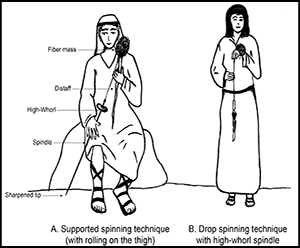Crossref Citations
This article has been cited by the following publications. This list is generated based on data provided by
Crossref.
Erez, Ben-Yosef
Yitzhak, Vassal
Edwin C.M., van den Brink
and
Ron, Beeri
2016.
A new Ghassulian metallurgical assemblage from Bet Shemesh (Israel) and the earliest leaded copper in the Levant.
Journal of Archaeological Science: Reports,
Vol. 9,
Issue. ,
p.
493.
Langgut, Dafna
Yahalom-Mack, Naama
Lev-Yadun, Simcha
Kremer, Eitan
Ullman, Micka
and
Davidovich, Uri
2017.
On Chalcolithic maceheads and spinning implements.
Antiquity,
Vol. 91,
Issue. 357,
p.
777.
Ben-Yosef, Erez
Shamir, Orit
and
Levy, Janet
2017.
On early metallurgy and textile-production technologies in the southern Levant: a response to Langgutet al.(2016).
Antiquity,
Vol. 91,
Issue. 357,
p.
765.
Gilligan, Ian
2018.
Climate, Clothing, and Agriculture in Prehistory.
Namdar, Linoy
Vardi, Jacob
Paz, Yitzhak
and
Sapir-Hen, Lidar
2021.
Variation in economic specialization as revealed through the study of Pottery Neolithic faunal assemblages from the southern Levant.
Archaeological and Anthropological Sciences,
Vol. 13,
Issue. 11,
Langgut, Dafna
Cheddadi, Rachid
and
Sharon, Gonen
2021.
Climate and environmental reconstruction of the Epipaleolithic Mediterranean Levant (22.0–11.9 ka cal. BP).
Quaternary Science Reviews,
Vol. 270,
Issue. ,
p.
107170.
Langgut, Dafna
Tepper, Yotam
Benzaquen, Mordechay
Erickson-Gini, Tali
and
Bar-Oz, Guy
2021.
Environment and horticulture in the Byzantine Negev Desert, Israel: sustainability, prosperity and enigmatic decline.
Quaternary International,
Vol. 593-594,
Issue. ,
p.
160.
Langgut, Dafna
and
Garfinkel, Yosef
2022.
7000-year-old evidence of fruit tree cultivation in the Jordan Valley, Israel.
Scientific Reports,
Vol. 12,
Issue. 1,
Liu, Li
Levin, Maureece J.
Klimscha, Florian
and
Rosenberg, Danny
2022.
The earliest cotton fibers and Pan-regional contacts in the Near East.
Frontiers in Plant Science,
Vol. 13,
Issue. ,
Muti, Giulia
2022.
Through the Eye of a Needle.
Near Eastern Archaeology,
Vol. 85,
Issue. 1,
p.
24.
Rosenberg, Danny
Galili, Ehud
and
Langgut, Dafna
2023.
The Unseen Record: Ninth–Seventh Millennia Cal. BP Wooden and Basketry Objects from Submerged Settlements off the Carmel Coast, Israel.
Forests,
Vol. 14,
Issue. 12,
p.
2373.
Vardi, J.
Yegorov, D.
Degen-Eisenberg, D.
Boaretto, E.
Langgut, D.
Avni, Y.
and
Caracuta, V.
2023.
The utilization and extinction of Juniper trees from the Negev desert (Israel) - Data from a late 6th–5th millennia site of Har Harif.
Journal of Arid Environments,
Vol. 210,
Issue. ,
p.
104906.
Akram, Hafiz Wasim
and
Degen, A. Allan
2023.
The Garment Economy.
p.
15.
Shemer, Maayan
Boaretto, Elisabetta
Greenbaum, Noam
Bar-Yosef Mayer, Daniella E.
Tejero, Jose-Miguel
Langgut, Dafna
Gnezdilov, Dariya Lokshin
Barzilai, Omry
Marder, Ofer
and
Marom, Nimrod
2023.
Early Upper Paleolithic cultural variability in the Southern Levant: New evidence from Nahal Rahaf 2 Rockshelter, Judean Desert, Israel.
Journal of Human Evolution,
Vol. 178,
Issue. ,
p.
103342.
Yashuv, Talia
Grosman, Leore
and
Groman-Yaroslavski, Iris
2024.
12,000-year-old spindle whorls and the innovation of wheeled rotational technologies.
PLOS ONE,
Vol. 19,
Issue. 11,
p.
e0312007.
Abadi, Itay
Torfstein, Adi
Friesem, David E.
Langgut, Dafna
Jin, Minji
Rabinovich, Rivka
Steiner, Tikvah
Zurro, Debora
Gur-Arieh, Shira
Ovadia, Ahiad
and
Goring-Morris, Adrian Nigel
2024.
Heinrich Event 2 (ca. 24 ka BP) as a chrono-climatic anchor for the appearance of Epipaleolithic backed bladelets microlith industries in the Southern Levant.
Quaternary Science Reviews,
Vol. 332,
Issue. ,
p.
108649.
Tao, Yuan
and
Wang, Qicai
2024.
Study on the prehistoric decorated spindle whorls in Haidai region of China.
Heritage Science,
Vol. 12,
Issue. 1,



